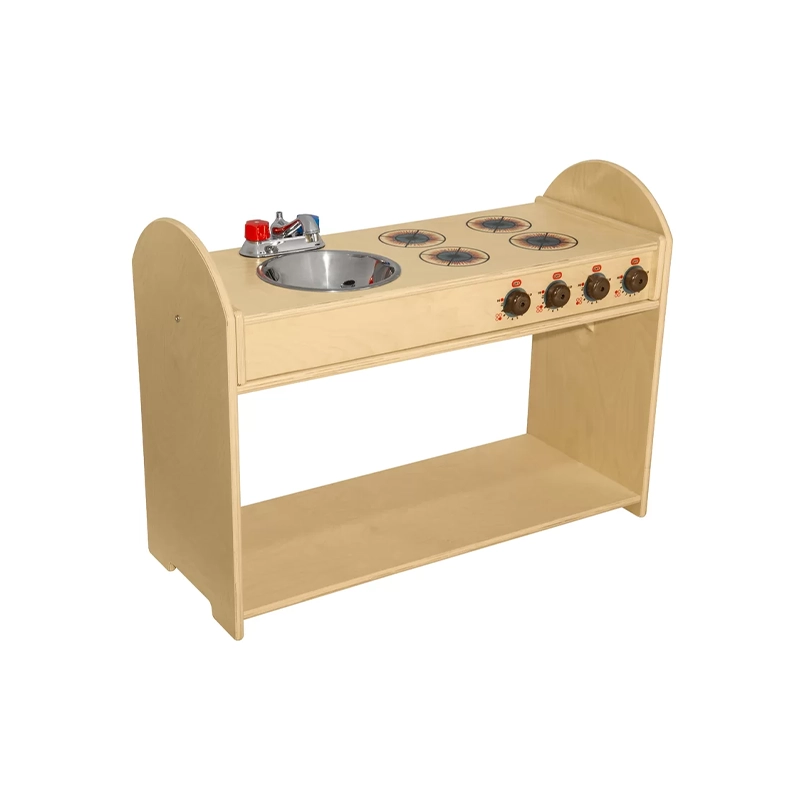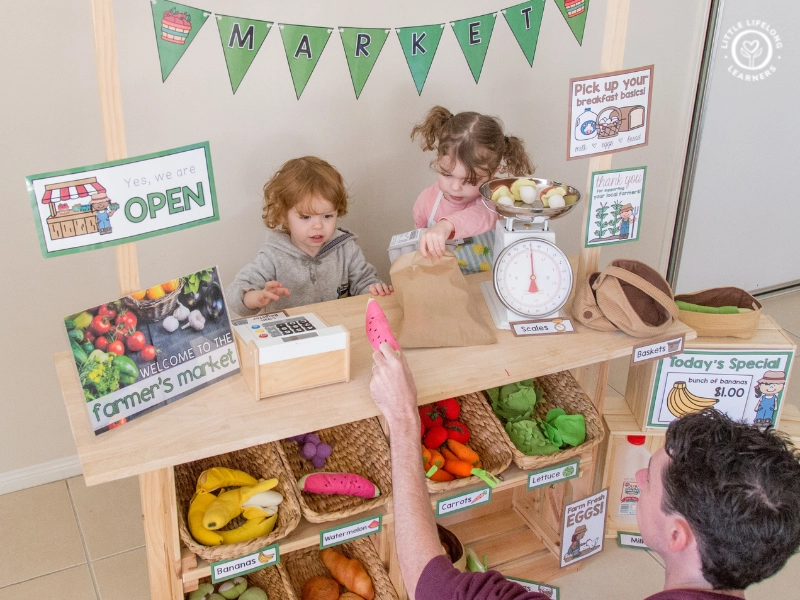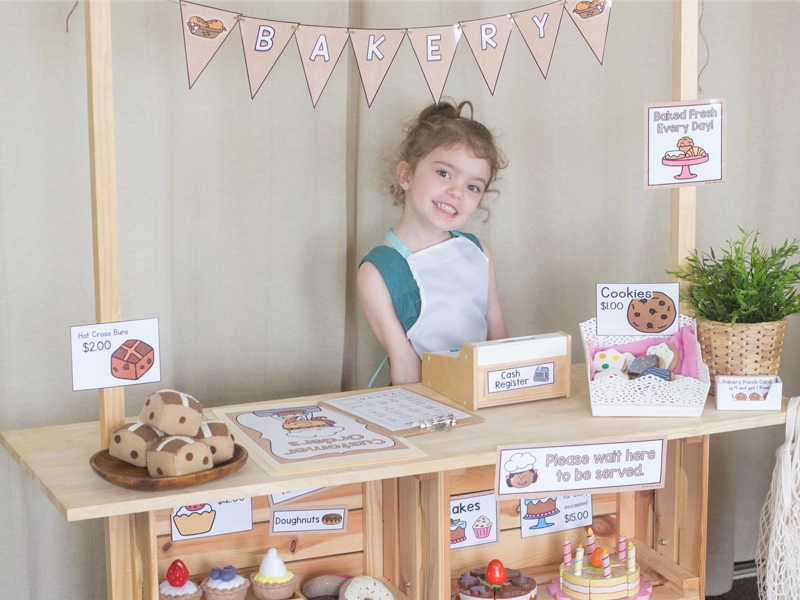
創造的な学習のための革新的なドラマティック・プレイ家具
イケアの高級劇遊び用家具とアクセサリーで、子どもたちの想像力と社会性を育みましょう。おままごとキッチンからおままごとステーションまで、当社の考え抜かれたデザインの製品は、幼稚園や幼児教室での共同作業、創造性、言葉の発達を促すように作られています。安全性、耐久性、機能性を追求したこれらの製品は、あらゆる学習環境に最適です。
学習環境のための劇用家具の種類
幼児教育の現場で想像力豊かなおままごとをサポートするために考え抜かれた、劇遊び用の家具やアクセサリーの多彩なコレクション。おままごとキッチン、マーケット屋台、着せ替えセンターなど、どの商品も耐久性、安全性、遊び心に優れています。丈夫で魅力的なドラマティック・プレイ・ファニチャーで教育スペースを充実させ、すべてのプレイタイムを楽しく教育的なものにしましょう。

キッチンセンター

シンク機器

幼児用キッチンセット

オープン・スペース・キッチン・セット

洗濯乾燥機

人形劇場

ドレスアップ・アイランド

食料品店セット

キッチン木製冷蔵庫

動物フィギュア

ランドリーセット

ほうきとお掃除セット
教室用家具の信頼できるメーカー
ウイニング・キッズでは、20年以上にわたる教育用家具の設計・製造の経験を活かしています。魅力的で耐久性のあるドラマティック・プレイ・ファニチャーを製作する当社の専門知識は、幼児期の発達をサポートする方法についての長年の理解に基づいています。私たちは、お子様の想像力豊かな遊びを刺激し、長持ちする、高品質でお子様に安全な製品をお届けすることで、高い評価を得ています。
当社のドラマティック・プレイ用家具は、子どもたちの教育的ニーズを念頭に置いて考え抜かれたデザインです。私たちは、社会性の発達、コミュニケーション能力の向上、認知力の成長を促す製品づくりに力を注いでいます。ロールプレイング(役割演技)を通して、子どもたちがさまざまな役になりきり、共感力や問題解決力、協調性を育みます。
ウイニングキッズでは安全性を最優先しています。ウイニング・キッズのドラマティック・プレイ用家具は、厳格な安全基準に準拠した、無害でお子様に優しい素材で作られています。私たちは、家具は楽しく魅力的なものであると同時に、忙しい教室で日常的に使用できる丈夫で安全なものであるべきだと考えています。すべての製品は、安全性と耐久性の最高基準を満たしていることを確認するため、徹底的なテストを受けています。
劇遊び用家具の素材
劇遊び家具に使用される素材は、製品の安全性と耐久性を確保する上で重要な役割を果たします。Winning Kidzでは、お子様に優しく耐久性のある素材を厳選しています。以下は、劇遊び家具によく使用される素材の一部です。
-
木材 木材は耐久性と魅力に優れ、劇遊びの家具に自然な雰囲気を与えます。責任ある調達によって、強度と持続可能性を兼ね備えています。バーチ材、メープル材、オーク材といった一般的な木材は、滑らかで丈夫です。安全のため、無毒で子供に安全な塗料や仕上げ材を使用するようにしてください。
-
プラスチック プラスチックは軽量で手頃な価格、お手入れも簡単で、鮮やかな色が豊富に揃っています。耐久性は高いものの、木や金属に比べて摩耗が早い場合があります。安全のため、BPAフリー、フタル酸エステルフリーのプラスチックであることを確認してください。
-
布張り 柔らかくて快適な生地は、人形劇やままごとキッチンなどの劇遊びエリアに、お子様にとって心地よい空間を演出します。安全のため、汚れにくく、難燃性で、無毒の生地をご使用ください。
-
ラミネート ラミネートはお手入れが簡単で、様々な色や柄からお選びいただけます。耐久性があり、汚れ、傷、こぼれにも強いので、人通りの多い場所に最適です。有害な化学物質を避けるため、低VOCまたは無毒のラミネートをお選びください。
-
金属 金属は洗練されたモダンな外観で、収納や強度が必要な家具に最適です。重量があるため、鋭利な角には注意が必要ですが、粉体塗装仕上げにより錆びにくくなっています。
-
フォームとパディング フォームは、快適性と安全性を兼ね備えた、座席やソフトプレイ家具によく使用されています。有害な化学物質が含まれていないことを保証するために、CertiPUR-US認証を受けたフォームを選びましょう。
ドラマティック・プレイとは何か?
劇遊びは幼児教育の基本的な要素であり、創造性、社会性、そして情緒の発達を促進します。子どもたちにロールプレイングの機会を与えることで、子どもたちは様々な視点を探り、問題を解決し、感情を表現することを学びます。
劇遊びは、ごっこ遊びやロールプレイとも呼ばれ、子どもたちが役を演じ、物語やシナリオを演じる遊びです。この遊びは、認知能力や社会性、感情の発達に不可欠です。お医者さん、シェフ、宇宙飛行士など、劇遊びは現実の状況を模倣することで、子どもたちが周囲の世界を理解するのに役立ちます。私たちの特別に設計された劇遊び用家具とプレイセットは、教室やプレイルームでのこうした体験をより豊かにするために作られています。
演劇の種類は何ですか?

- 構造化された劇遊びこのタイプのロールプレイでは、事前に決められた役割とシナリオに基づいて、子どもたちは医者、先生、親などのなりきり行為を行います。多くの場合、聴診器やおもちゃの電話といった小道具が使われます。この遊びは、子どもたちが社会的な役割を理解し、言語スキルを練習し、制御された枠組みの中で社会的な交流能力を育むのに役立ちます。構造化された遊びは、子どもたちが特定のルールやガイドラインに従うことを促し、境界線や期待されるものへの理解を育みます。
- 構造化されていない劇的な遊び一方、構造化されていない遊びはより自由度が高く、子どもたちが登場人物、シナリオ、物語を自由に創造することができます。例えば、動物、スーパーヒーロー、空想上の生き物になりきったり、小道具や設定を自ら考え出したりします。こうした遊びは、子どもたちが自由に物語を探求し、形作ることができるため、創造性、想像力豊かな思考、そして問題解決能力を高めます。構造化されていない遊びは、子どもたちに、より流動的で自発的な方法で、自己表現の柔軟性と批判的思考力を育む機会を与えます。

幼稚園児向けの劇遊びのアイデア
| 劇的演劇のテーマ | 説明 | 利点椅子の座面の高さ | 必要な材料 |
|---|---|---|---|
| プレイキッチン | 子どもたちは料理をしたり、食事を出したり、レストランやキッチンを管理したりすることを真似します。 | 創造性、細かい運動能力、日常の習慣の理解を育みます。 | プレイキッチンセット、食品、調理器具、エプロン。 |
| 診療所 | 子どもたちは医師、看護師、患者の役割を演じ、医療行為を模倣します。 | 共感力、コミュニケーション能力、社会的交流を養います。 | おもちゃの医療キット、包帯、医者の衣装、患者用ベッド。 |
| スーパーマーケット | 子どもたちが食料品を「購入」し「支払い」をしながら、基本的な算数と社会性を練習できる、ごっこ遊びの食料品店です。 | 数え方、お金の概念、社会的な交流を教えます。 | おもちゃのレジ、食品、買い物かご。 |
| 建設現場 | 子どもたちは建築者になりきって、道具を使って建物や道路を「建設」します。 | チームワーク、問題解決能力、運動能力を促進します。 | おもちゃの道具、積み木、ヘルメット、安全ベスト。 |
| 消防署 | 子どもたちは消防士の役割を演じて、「火」を消したり人々を助けたりします。 | チームワーク、身体活動、コミュニティヘルパーの理解を促進します。 | 消防士の帽子、ホース(おもちゃ)、救助用具。 |
| 郵便局 | 子どもたちが手紙や荷物を仕分けして「配達」する、おままごと郵便局。 | 言語スキル、責任感、コミュニティの役割に対する理解を養います。 | 手紙、封筒、切手、おもちゃの郵便受け。 |
幼児期の発達における劇遊びの利点
劇遊びは、ロールプレイを通して子どもたちが世界を探求するのを助けます。批判的に考え、自分の考えや感情を表現し、社会的な人間関係を築くことを促します。主なメリットをいくつか見ていきましょう。
認知発達
子どもたちは、想像力、言語能力、そして問題解決能力を刺激する劇的な遊びのシナリオに取り組みます。例えば、「お店屋さんごっこ」や「レストランごっこ」は、数、構成、そして物語の理解を深めます。
ソーシャル・スキル
子どもたちはロールプレイング活動を通して、順番を守る、協力する、対立を解決するといった基本的な社会スキルを学びます。また、他人の立場になって考えることで、共感力も養います。
感情の発達
劇遊びは、様々な登場人物を通して感情を表現することで、子どもたちの感情を整理するのに役立ちます。こうした感情表現は、自己制御能力を高め、他者の感情を理解する力を高めます。
創造性と想像力
ごっこ遊びは子どもの想像力を解き放ちます。頭の中で様々な世界を創造することを促し、創造性を高め、既成概念にとらわれない思考力を育みます。
言語発達をサポート
劇遊びを通して、子どもたちは様々な状況で新しい単語やフレーズを試しながら、自然と語彙を増やしていきます。さらに、劇遊びの中で物語を語ることで、子どもたちは物語の構造をより深く理解し、コミュニケーション能力を高めることができます。
未就学児向けの劇遊びアクティビティ
劇遊びは、未就学児にとって最も楽しく、教育的なアクティビティの一つです。幼い子どもたちは、様々な役割を演じ、想像力を膨らませ、周りの世界で様々なことに挑戦することができます。お医者さん、シェフ、スーパーヒーローなど、どんななりきりでも、これらのアクティビティは創造性、コミュニケーション能力、そして問題解決能力を育みます。様々な場面を演じることで、未就学児は楽しみながら、共感力、社会性、感情表現といった生活に欠かせないスキルを身につけていきます。

フラワーショップ演劇

郵便局の劇

ファーマーズマーケットの劇

食料品店の劇遊び

キャンプ劇遊び

医者のオフィス劇
さまざまな年齢層向けの劇遊び
劇遊びは子どもの成長に合わせて進化し、さまざまな年齢層に適したさまざまな種類のゲームがあります。

(1~3歳)
幼児向けの劇遊び
この段階では、子どもたちは単純で感覚を刺激する遊びに取り組みます。幼児向けの劇遊びには、簡単なキッチンセット、子供用の家具、シンプルな衣装などを使うことがあります。料理をしたり、人形に餌をあげたりといった、大人の身近な行動を真似し始めます。

(3~5歳)
幼児向け劇遊び
未就学児は、お医者さん、先生、消防士など、より複雑なロールプレイングのシナリオに取り組みます。遊び場には、プレイハウス、動物病院、市場の屋台など、より大規模で詳細な設定が含まれることもあります。この年齢では、劇遊びを通して社会性、協力、問題解決能力が育まれます。

(5~7歳)
学齢期の子供たち
この段階の子どもたちは、協力的なグループ遊びや、より複雑な物語の語り合いに取り組みます。劇遊びのエリアには、郵便局、工事現場、スーパーヒーローステーションといったテーマに沿った設定が含まれる場合があります。こうした環境は、チームワーク、交渉、役割分担を促します。
異なる教育哲学における劇遊び
劇遊びは様々な教育哲学に取り入れられ、それぞれ独自のアプローチがあります。様々な教育方法における劇遊びの表現例をご紹介します。
モンテッソーリ教育
モンテッソーリ教育では、劇遊びは多くの場合、子ども主導で行われます。子どもたちは、自ら選んだ活動を通して、現実世界のシナリオを探求するよう促されます。子どもが自分の遊び場を管理し、小道具を選び、シナリオを組み立てるなど、自立心を育むことに重点が置かれています。
レッジョ・エミリア・アプローチ
レッジョ・エミリアでは、劇遊びは子どもたちが自己表現し、コミュニケーションを取り、仲間と交渉する手段とみなされています。ここでは、教育者は、劇遊びを象徴的な表現の手段と捉え、豊かで協調的な環境づくりに重点を置いています。教材は自然で自由な発想のものが多く、想像力を刺激するように作られています。
ヴァルドルフ教育
ヴァルドルフ教育は、想像力豊かな表現を重視した劇遊びを統合しています。教師は、物語やロールプレイングを用いて子どもたちの遊びを導き、子どもたちを芸術的・情緒的発達へと導きます。ヴァルドルフの教室で使われる小道具や舞台装置は、多くの場合、シンプルで自然なものとなっています。
伝統的な教育
伝統的な教育現場では、劇遊びはより体系化されており、教師が遊びの活動を指導します。家具や遊具はテーマに沿って設計されることが多く、地域社会の役割や家族の力関係の理解といった特定の学習目標に合わせて設計されています。構造化されたロールプレイング活動を通して、社会的な交流と学習に重点が置かれます。
教室に劇遊び場を作る方法
子どもたちの創造性、社会性、そして問題解決能力を育むには、劇遊びの場を作ることが不可欠です。教室に最適な劇遊びの場を作るためのステップバイステップガイドをご紹介します。
1. 適切な場所を選ぶ
教室内の広々としたコーナーまたは専用エリアを選びましょう。このエリアはアクセスしやすい場所であるべきですが、騒がしい遊び場や人通りの多い場所など、気が散るものから近すぎないようにする必要があります。自由に動き回り、協力し合い、あらゆる小道具や家具に簡単にアクセスできるスペースを確保しましょう。
2. 年齢に適した家具を使う
年齢に適した、丈夫で安全な家具を使いましょう。幼児には、低くて丈夫なテーブルと小さめの家具を検討しましょう。年長児には、大きめのプレイハウスや舞台セット、医療キット、キッチンセット、レジといった細かい小道具を用意すると良いでしょう。
3. 遊び場を作る
劇遊びエリアをテーマごとにゾーンに分けると効果的です。例えば、「キッチン」「お医者さんのオフィス」「お店」などです。それぞれのゾーンには、ロールプレイや想像力豊かな探求を促すような家具や小道具を配置しましょう。
4. 小道具や衣装を追加する
劇遊びの創造性を刺激するには、小道具が欠かせません。衣装、キッチン用品、医療器具、買い物かご、おもちゃのお金など、様々なアイテムを用意しましょう。小道具は箱や棚に整理して取り出しやすくし、テーマに合わせて入れ替えることで、遊びを楽しく新鮮に保ちましょう。
5. 明確な期待を設定する
エリアの準備ができたら、そのスペースの使い方について明確なガイドラインを作りましょう。役割を説明し、小道具の共有方法を見せ、子どもたちが協力して遊ぶように促しましょう。「順番を守る」「おもちゃを共有する」「優しい言葉をかける」といった簡単なルールを教えるのも良いでしょう。
6. 観察して適応する
子どもたちが遊び場を使う際、小道具や他の子どもたちとどのように関わっているか観察してみましょう。遊び場が子どもたちの興味を引き、学習をサポートできるよう、環境を調整しましょう。特定のテーマに子どもたちの興味が向かない場合は、テーマを変えたり、新しい教材を追加したりすることを検討しましょう。
屋内と屋外の劇遊びセンター
劇遊びは屋内教室だけに限りません。屋内と屋外の劇遊び環境には、それぞれ独自の利点と課題があります。

屋内劇遊び
屋内空間はより細かく設定ができるため、ごっこ遊びのキッチン、診療所、お店など、細部までこだわった空間を作ることができます。こうした空間は、子どもたちが現実の環境を模倣したロールプレイングに取り組むきっかけとなります。また、家具の配置や小道具の収納など、より自由にカスタマイズできます。

屋外劇遊び
屋外の劇遊び場は、一般的に広く、身体活動に重点を置いています。屋外キッチン、プレイハウス、マーケットの屋台などは、子どもたちがより活発で社交的な環境で想像力を働かせる機会を提供します。屋外遊びは身体活動を促進し、運動能力を高めます。
劇的な遊び場の維持
劇的な遊び場を維持することは、家具が安全で機能的であり、学習に役立つことを保証するために不可欠です。
-
定期的な清掃 特に人の出入りが多い場所では、すべての家具や遊具を定期的に消毒し、拭き掃除をしてください。安全のため、無毒でお子様にも安全な洗剤を使用してください。
-
損傷の検査 ひび割れ、ネジの緩み、角の破損など、すべての部品の摩耗や損傷を点検してください。安全な環境を維持するために、損傷した家具は速やかに修理または交換してください。
-
回転再生テーマ 劇遊びエリアを常に新鮮で魅力的な空間に保つには、テーマや家具を定期的に入れ替えましょう。そうすることで、子どもたちが新しい役割を探求する意欲が湧き、空間に活気が生まれます。
-
安全チェック 遊び用の家具はすべて安全基準を満たし、転倒防止のためしっかりと固定されていることを確認してください。鋭利な角は避け、緩んだ部分はしっかりと固定してください。
-
清潔で整理された空間を作る 整理整頓された劇遊びエリアは、子どもたちが簡単に材料にアクセスでき、自立した遊びを促します。衣装、アクセサリー、小道具は、ラベルを貼った箱に保管し、簡単に識別できるようにしましょう。
よくあるご質問
ドラマティック・プレイの対象年齢は?
ドラマティック・プレイは、2歳から6歳までの子どもに最も効果的である。この時期の子どもは、実世界のシナリオを探検したり模倣したりしながら、自然に想像力豊かなロールプレイをするようになる。しかし、年長の子どもは、より複雑な劇遊びにも参加することができ、より深い問題解決と社会的相互作用を育むことができる。
幼児期における劇遊びの利点とは?
幼児期の劇遊びは、創造性、言語発達、感情調節、社会性を促進する。子どもたちは、想像力豊かなシナリオを通して、自分の感情を表現し、問題を解決し、異なる視点を理解することを学ぶ。また、チームワークや協調性も養われる。
ドラマティック・プレイをサポートするには?
劇遊びをサポートするために、コスチューム、食べ物、道具、家具など、創造性を刺激する自由な小道具をいろいろ用意する。教室や家に劇遊びのための居心地のよい空間を作り、必要に応じて子どもたちに役割やシナリオを提案し、導いてあげましょう。遊びの中で、子どもたちが協力し、想像力を働かせるようにしましょう。
なぜドラマチックなプレーが重要なのか?
ドラマチックな遊びは、子どもたちが重要なライフスキルを身につけるのに役立つからだ。ドラマティック・プレイは、問題解決能力、批判的思考、言語能力を育むことによって、認知の発達を促す。さらに、子どもたちがさまざまな感情やシナリオをナビゲートすることで、情緒の発達をサポートし、協力、共感、コミュニケーションなどの社会的スキルを促進する。
劇遊びは子どもの発達にどのように役立つのか?
劇遊びは、子どもの認知的、社会的、情緒的発達に大きく寄与する。新しい語彙や文型の使用を促すことで、言語の発達を高める。社会的な面では、協力と衝突の解決を教える。情緒面では、子どもはさまざまな感情を探求し、自己調節の練習をすることができる。
教室に劇遊びのエリアを設置するにはどうすればよいですか?
劇遊びの場を設けるには、教室の一角やスペースに、子どもたちがおままごとに参加できる場所を確保する。着せ替え用の洋服やキッチン用品、家庭用具などの小道具も用意する。キッチン、病院、お店など、さまざまなテーマに基づいてスペースを設計する。整理整頓を心がけ、小道具を定期的に入れ替え、子どもたちが自由に動けるスペースを確保する。
内気な子供たちに劇遊びへの参加を促すにはどうしたらいいでしょうか?
内気な子供を励ますには、他の子供と1人か2人で遊べるような、小さくてプレッシャーの少ない活動から始める。家族の一員やペットのような、快適で親しみやすい役割を与える。積極的な強化策を用い、参加したことを褒め、遊びの中で子どもたちと一緒に行動することで行動を模範化する。自信がついてきたら、徐々にシナリオを複雑にしていく。
子どもたちはどれくらいの頻度で劇遊びをするべきか?
劇遊びは子どもの成長にとって非常に重要であるため、理想的には毎日、あるいは週に数回、定期的に取り組むべきである。新しいスキルを練習し、自分や他人について学ぶのに役立ちます。構造化された遊びと構造化されていない遊びの両方の時間を設けることで、子どもたちは想像力を働かせ、仲間と社会的に関わることができます。



